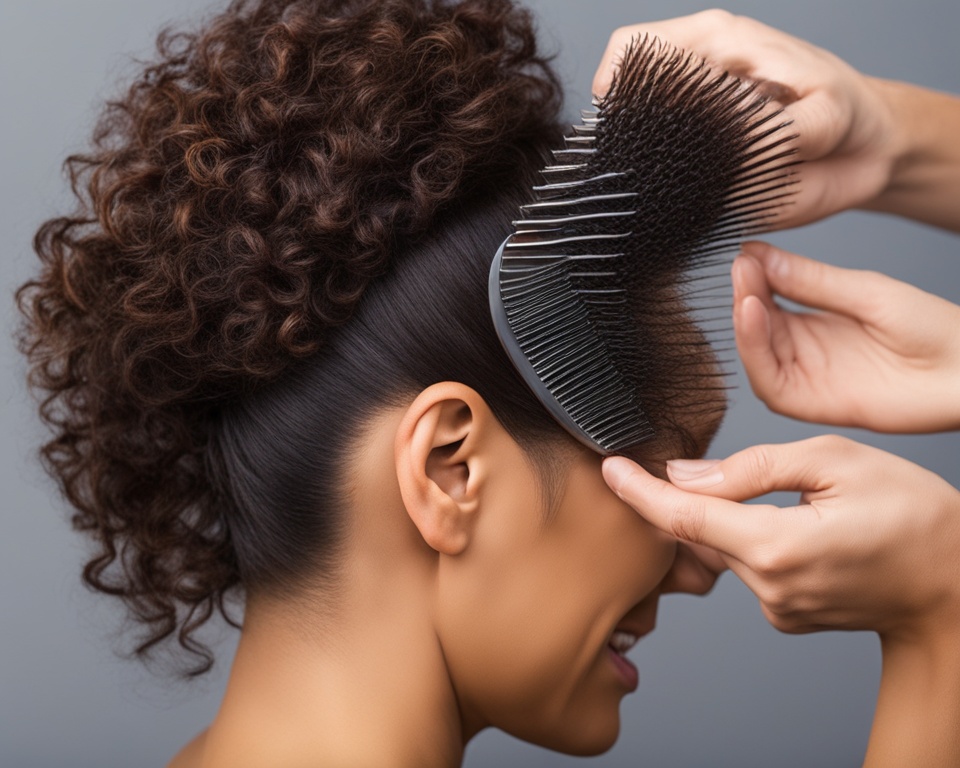Women often feel less confident when they lose or thin out their hair. But, thanks to new hair restoration tech, there’s hope. Hair implants for women are now a real solution. This guide will cover the benefits, how it’s done, and what to think about if you want to get your hair back.
Read interesting things at : vsocan
Key Takeaways
- Hair implants offer an effective solution for women experiencing hair loss or thinning hair
- The procedure can help restore natural-looking hair and boost self-confidence
- Understanding the different types of hair loss and their causes is crucial
- Proper consultation and evaluation are essential before undergoing the hair implant process
- Choosing the right hair restoration specialist with the necessary credentials and experience is vital
Understanding Female Hair Loss
Hair loss is a big worry for many women around the world. It’s important to know the different types and causes of hair loss. This helps find the best solutions. We’ll look at the various types of hair loss in women and what causes them.
Types of Hair Loss in Women
Androgenetic alopecia, or female pattern baldness, is the most common type of hair loss in women. It leads to a slow thinning of hair, starting at the part and spreading over the scalp. Other types include telogen effluvium, which is caused by stress or hormonal changes, and alopecia areata, an autoimmune disorder leading to patchy hair loss.
Causes and Risk Factors
- Hormonal imbalances, including changes in estrogen, progesterone, and testosterone levels
- Genetic predisposition, as female pattern baldness can be inherited
- Medical conditions such as thyroid disorders, anemia, and polycystic ovarian syndrome (PCOS)
- Certain medications, including those used for cancer treatment, depression, and high blood pressure
- Stress, both physical and emotional, which can trigger or worsen hair loss
- Nutritional deficiencies, particularly in proteins, iron, and vitamins
- Hairstyles that put excessive tension on the hair, such as tight ponytails or braids
Knowing the causes and risk factors for female hair loss types is key to finding solutions. With this knowledge, women can work with their doctors to create personalized treatment plans. This helps them regain their confidence.
“Hair loss can have a big impact on a woman’s self-esteem and well-being. By addressing the root causes, we can help restore not just the hair, but also the confidence and quality of life.”
| Type of Hair Loss | Characteristics | Causes |
|---|---|---|
| Androgenetic Alopecia | Gradual thinning, often starting at the part line and spreading across the top of the scalp | Genetic predisposition, hormonal imbalances |
| Telogen Effluvium | Excessive shedding of hair, often triggered by stress or hormonal changes | Stress, hormonal changes, certain medications |
| Alopecia Areata | Patchy hair loss, caused by an autoimmune disorder | Autoimmune disorder |
What Are Hair Implants?
Hair implants, also known as hair transplantation, are a way to restore a full, natural-looking head of hair. This method takes healthy hair follicles from one part of the scalp and moves them to where hair is thinning or gone. It makes the hair look fuller and can greatly improve self-confidence.
The main hair grafting techniques are follicular unit extraction (FUE) and follicular unit transplantation (FUT). Both methods move individual hair follicles carefully. This ensures the new hair looks natural and fits well with the rest of your hair.
The Hair Implant Process
A hair implant starts with finding the best donor site on the scalp, often from the back or sides. Then, the surgeon uses special tools to take out individual hair follicles. These follicles are moved to where more hair is needed.
These transplanted follicles grow and make the hair look fuller and younger over time. With good care, the results can last for years. This gives a lasting solution for women with hair loss.
“Hair implants have given me a newfound sense of confidence and self-assurance. I no longer have to worry about thinning or balding areas, and can enjoy a full, healthy head of hair.”
The success of hair implants depends on the surgeon’s skills and experience. It’s important to pick a specialist who is certified and has a good track record. This ensures you get natural-looking and high-quality results.
Benefits of Hair Implants for Women
Hair implants change lives for women with hair loss or thinning. They bring back a full, natural look. This isn’t just about looks; it’s about feeling good and boosting confidence.
Restore Natural-Looking Hair
Hair implants make hair look natural and full. They use your own hair for the transplant. This means the new hair matches your existing hair perfectly.
This careful matching makes the new hair blend in well. You’ll look refreshed and rejuvenated, just like before.
Boost Self-Confidence
It’s not just about looking good. Hair implants can change how you feel inside. Hair is key to how we see ourselves. Getting your hair back can make you feel empowered.
Women often feel more confident and sure of themselves after hair implants.
“The hair implant procedure has given me back the confidence I lost due to thinning hair. I feel more like myself again, and it’s made a world of difference in how I present myself to the world.”
Hair implants tackle the real cause of hair loss. They offer a lasting solution. This helps women feel confident and beautiful again.
| Benefit | Description |
|---|---|
| Natural-Looking Hair | Hair implants use the patient’s own hair follicles, ensuring a seamless, natural-looking result that blends with the existing hairline. |
| Improved Self-Confidence | Restoring a full head of hair can have a profound impact on a woman’s self-image and overall well-being, boosting confidence and self-assurance. |
Preparing for a Hair Implant Procedure
When thinking about hair implants, the first step is meeting with a hair restoration expert. This meeting is key to figuring out the best way to fix your hair loss.
Consultation and Evaluation
In the hair implant consultation, a specialist will check your hair and scalp closely. They look at:
- Your hair loss pattern and how thick your hair is
- How much good hair you have to use for the implant
- The reasons behind your hair loss
- What you hope to achieve with the hair restoration
After this detailed check-up, your specialist will make a plan just for you. This plan aims to meet your specific needs for the best results.
This consultation is very important. It helps your specialist understand your situation and offer advice just for you. This way, the hair implant procedure will be made just for you, giving you natural-looking, lasting results.
“The consultation with my hair restoration specialist was truly eye-opening. They took the time to thoroughly evaluate my hair and scalp, and then developed a treatment plan that addressed my specific concerns. I felt confident and informed every step of the way.”
Working with a skilled professional and following their advice is key. It’s the first step towards making your hair look great and boosting your confidence.
The Hair Implant Process
The hair implant procedure is a detailed process that makes hair look natural again. It involves taking hair follicles from one part of the scalp and moving them to another. This makes the hair look full and natural.
First, the surgeon takes hair follicles from the back and sides of the scalp. These areas usually have strong, healthy hair. This is where the new hair will come from.
- Donor Hair Extraction: The surgeon uses special tools to take out the hair follicles without scars.
- Graft Preparation: The taken follicles are sorted, trimmed, and readied for the new spot.
- Implantation: The surgeon places the grafts carefully to look natural and full.
The surgeon is very precise and artistic during the process. They make sure the hair looks great and meets the patient’s needs. This makes the results look very natural and pleasing.
“The hair implant procedure is a transformative experience that can dramatically improve one’s appearance and self-confidence. The results are natural-looking and long-lasting, making it a highly sought-after solution for those dealing with hair loss or thinning.”
This procedure is a proven way to restore hair and boost confidence. Knowing how it works helps people decide if it’s right for them.
Follicular Unit Extraction (FUE) Technique
The Follicular Unit Extraction (FUE) technique is a leading method in hair restoration. It’s a minimally invasive way to move healthy hair follicles to thinning areas. This leads to natural-looking hair with little to no scarring.
Understanding FUE
The FUE hair transplant is precise, unlike older methods. It doesn’t take a strip of scalp like Follicular Unit Transplantation (FUT). Instead, it carefully moves individual follicular units from the back or sides of the head.
Skilled surgeons use special tools to take out each follicular unit. These units have one to four hairs. This method means a quicker recovery and less chance of visible scars. It’s a great choice for women looking into follicular unit extraction, FUE hair transplant, or minimally invasive hair restoration.
| Technique | Extraction Method | Scarring | Recovery Time |
|---|---|---|---|
| FUE | Individual Follicular Units | Minimal | Faster |
| FUT | Strip of Scalp | Linear Scar | Slower |
The FUE technique is precise and minimally invasive. It’s great for women wanting natural-looking hair with less downtime and scarring. By understanding FUE, people can make better choices for their hair restoration. This can help them feel more confident.
“The FUE technique has been a game-changer for women seeking to restore their natural-looking hair with minimal downtime and scarring.”
Follicular Unit Transplantation (FUT) Technique
The Follicular Unit Transplantation (FUT) technique is a top choice for those wanting to get back their full, youthful hair. It takes a strip of scalp with healthy hair follicles and moves it to where it’s needed. This is different from the Follicular Unit Extraction (FUE) method.
First, the surgeon takes a thin strip of skin from the back of the scalp. This strip has thousands of follicular units, which are groups of 1-4 hairs. These units are key to healthy hair growth.
| Technique | Description | Advantages | Disadvantages |
|---|---|---|---|
| Follicular Unit Transplantation (FUT) | A strip of scalp containing healthy hair follicles is removed and transplanted to the desired areas. |
|
|
Then, the strip is cut into individual follicular units under a microscope. This careful work makes sure each hair follicle is safe and ready for the transplant.
After preparing the grafts, the surgeon puts them into the scalp where they will grow new hair. The follicular unit transplantation method is great at filling in big areas of hair loss.
The FUT hair transplant takes a bit longer to recover from than other methods. But, the results can change a woman’s life, boosting her confidence and beauty.
“The FUT technique has been a game-changer for my patients, allowing us to achieve remarkable results in even the most complex cases of female hair loss.”
– Dr. Sarah Jennings, Board-Certified Hair Restoration Specialist
Non-Surgical Hair Replacement Options
For women dealing with hair loss, there are non-surgical options besides hair implants. These choices are great for those not suited for or not wanting a hair transplant. They offer a way to look better without surgery.
Hair integration systems attach natural or synthetic hair to what you already have. This makes your hair look fuller and thicker. Hair toppers for women cover thinning spots or bald areas on the scalp.
These non-surgical options have many benefits:
- Instant results with no downtime or recovery
- Customizable to match individual hair texture, color, and style preferences
- Reversible, allowing for flexibility and experimentation with different looks
- More affordable and accessible than surgical hair restoration procedures
Non-surgical hair replacements aren’t permanent but can help women feel better about their hair. It’s key to talk to a professional to find the best option for you.
| Non-Surgical Hair Replacement Options | Key Features |
|---|---|
| Hair Integration Systems |
|
| Hair Toppers for Women |
|
Hair integration systems and hair toppers for women are great for those wanting to fix hair loss without surgery. They offer quick results, can be tailored to your look, and are more affordable. This makes them a popular choice for many women.
hair implants for women
Women dealing with hair loss or thinning have unique needs for hair restoration. Hair implants are a key surgical option that helps women regain confidence and get natural-looking hair. This part looks at how hair implants help women achieve their goals.
One big plus of hair implants is they can fix a full, feminine hairline. Female hair loss treatment often means dealing with thinning or receding hairlines, not like men’s bald spots. Hair implants place grafts precisely for a natural look that boosts a woman’s look and confidence.
Surgical hair restoration for women also helps with sparse or thinning hair. This could be from hormonal issues, genetics, or other health problems. Hair implants can make hair look fuller and cover more of the scalp, boosting confidence and well-being.
Hair implants are a standout for hair regrowth solutions for women. They offer permanent results, unlike treatments that need constant use. This makes them a great choice for those wanting a lasting fix for hair loss.

“Hair implants have been a game-changer for me. I no longer feel self-conscious about my thinning hair, and the results have truly boosted my confidence and self-esteem.” – Emily, a satisfied hair implant patient.
Choosing hair implants means finding a skilled specialist who knows what women need. Working with the right expert and getting a detailed check-up ensures the procedure meets your goals. This way, women can get results that look natural and boost their confidence.
Recovery and Aftercare
Starting a hair implant is a big step towards getting your natural-looking hair back and feeling more confident. But, the recovery and aftercare are key to getting the best results. It’s important to follow the post-operative instructions closely for a smooth recovery.
Post-Operative Instructions
After your hair implant, your doctor will give you detailed instructions for recovery. These may include:
- Caring for the treated area by keeping it clean and protected
- Managing any discomfort or swelling with recommended medications
- Avoiding activities that could disrupt the healing process, such as strenuous exercise
- Attending follow-up appointments for progress monitoring and additional care
Following these instructions is key for a good hair implant recovery, post-op care for hair transplant, and aftercare for hair restoration. By listening to your doctor, you can make sure your hair implant works well and looks great.
| Aftercare Recommendation | Importance |
|---|---|
| Keeping the treated area clean and protected | Reduces the risk of infection and promotes healthy healing |
| Managing discomfort and swelling | Ensures a comfortable recovery and minimizes potential complications |
| Avoiding strenuous activities | Prevents disruption to the healing process and protects the transplanted hair |
| Attending follow-up appointments | Allows your healthcare provider to monitor progress and provide additional care as needed |
By sticking to the recommended hair implant recovery, post-op care for hair transplant, and aftercare for hair restoration guidelines, you can have a smooth recovery. This sets you up for the best results from your hair restoration.
“The key to a successful hair implant procedure is not just the surgery itself, but the diligent care and attention you give to your recovery and aftercare.”
Potential Risks and Complications
Hair implants are usually safe and effective for restoring hair. But, it’s key to know the possible risks and complications. Before getting a hair transplant, consider these factors.
One big risk of hair implants is getting an infection at the site. It’s vital to follow your surgeon’s post-op care to lower this risk. You might also face complications of hair transplant like scarring, bleeding, or nerve damage. These are rare if you choose a skilled, certified hair restoration expert.
Another side effect of hair restoration is temporary hair loss, or “shock loss.” This happens as new hair roots start to grow. It usually goes away in a few months as new hair grows in.
- Infection at the donor or recipient site
- Scarring or poor wound healing
- Bleeding or nerve damage
- Temporary shedding (“shock loss”) of transplanted hair
Talk about these risks of hair implants, complications of hair transplant, and side effects of hair restoration with your specialist before your procedure. They can offer advice on how to reduce risks and get the best results.
“Understanding the potential risks and taking the necessary precautions can help ensure a successful and satisfying hair implant experience.”
Choosing the Right Hair Restoration Specialist
Finding the right hair restoration specialist is key to getting natural-looking hair. It’s important to research and check out different providers. This ensures you get the best care and results for your hair.
Credentials and Experience
The qualifications and experience of a hair restoration specialist matter a lot. Look for a doctor who is certified in plastic surgery or dermatology, focusing on hair restoration. These doctors have had a lot of training. They know how to do hair implants well.
Also, think about how much experience the surgeon has with hair implants. Experienced hair transplant surgeons are more likely to give you the look you want. Ask about their success rates and look at before-and-after photos to see their work.
- Seek a hair restoration specialist who is board-certified in plastic surgery or dermatology
- Look for a provider with a lot of experience in hair implant procedures
- Review the surgeon’s portfolio of past patient results to see their skill and artistic eye
Choosing a hair restoration specialist with the right credentials and experience helps you get the look you want.

“The right hair restoration specialist can make all the difference in achieving the natural-looking results you desire.”
| Qualifications | Importance |
|---|---|
| Board Certification in Plastic Surgery or Dermatology | Ensures the surgeon has the necessary training and expertise to perform hair implant procedures successfully |
| Extensive Experience in Hair Transplant Surgeries | A high volume of previous procedures performed indicates the surgeon’s skill and ability to deliver natural-looking results |
| Positive Patient Testimonials and Before-and-After Photos | Provides insight into the surgeon’s artistry and the satisfaction of their past patients |
Hair Implants for Women: Real-Life Stories
Hair restoration has changed lives, especially for women who’ve tried hair implants. They’ve gained confidence and found their self-esteem again. These stories show how hair implants can truly change a person’s life.
Sarah, a 42-year-old marketing executive, had thinning hair due to hormonal issues. She tried many products but nothing worked. Then, she decided to get hair implants. Now, her hair looks and feels fuller, and she’s no longer self-conscious about her scalp.
“The results have been nothing short of amazing. My hair looks and feels fuller, and I no longer have to worry about hiding my scalp or wearing hats all the time.”
Emily, 35, felt insecure about her thinning hair. After her hair implant, she felt like a new person. The results were natural-looking, giving her a new confidence and freedom to style her hair.
These stories show how hair implants can change lives. They boost confidence and make women feel young again. Choosing hair implants can be a life-changing decision, as these stories prove.
Patient Testimonials for Hair Transplants
Happy patients share their success stories with hair implants. Here’s what they say:
“I’m so grateful for the incredible results of my hair implant procedure. The team was professional, compassionate, and truly dedicated to helping me achieve the full, healthy-looking hair I’ve always wanted.”
“After years of feeling self-conscious about my thinning hair, the hair implants have given me a newfound sense of confidence. I no longer have to worry about hiding my scalp, and I can style my hair however I please.”
| Patient Name | Age | Procedure | Results |
|---|---|---|---|
| Sarah Johnson | 42 | Hair Implant | Restored natural-looking, fuller hair |
| Emily Davis | 35 | Hair Implant | Increased confidence and self-esteem |
| Sophia Martinez | 28 | Hair Implant | Revitalized youthful appearance |
These patient testimonials for hair transplants show real, life-changing results. They highlight the impact of hair implants on women’s lives.
Financing Options for Hair Implants
The cost of hair implants can be a big worry for many women looking to restore their hair. But, there are ways to make these treatments more affordable. There are financing options and payment plans available.
Exploring Cost-Effective Solutions
Looking into hair implants means thinking about the cost. Prices can go from $4,000 to $15,000 or more. This depends on how much work needed and the specialist’s skills. Luckily, there are ways to make this cost easier to handle.
Payment Plans and Financing Assistance
Many clinics offer payment plans or partner with financing companies. These plans let you pay over time, often with little or no interest. This makes the procedure more affordable.
| Financing Option | Key Features |
|---|---|
| In-House Payment Plans | Offered directly by the hair restoration clinic, often with flexible terms and low-interest rates. |
| Third-Party Financing | Partnerships with external financing companies that provide loan options for hair implant procedures. |
| Medical Credit Cards | Specialized credit cards designed for healthcare expenses, with promotional financing options. |
Some patients can also use health savings accounts (HSAs) or flexible spending accounts (FSAs) to pay for their hair implants. This can help lower the cost even more.
Consulting with Specialists
When thinking about hair implants, talk to experienced specialists. They can give you a full cost breakdown and financing options. They’ll help you pick the best payment plan or financing solution for you.
Looking into financing options and payment plans helps women get hair implants within reach. This way, they can feel confident and happy with their look again.
Conclusion
Hair implants for women are a game-changer for those wanting to boost their confidence and get back their natural hair look. We’ve looked into different techniques, benefits, and things to consider. It shows that hair implants can really change lives for women dealing with hair loss or thinning.
This guide has highlighted the key points about hair restoration for women. It’s important to know the causes of hair loss, the options available, and finding a skilled specialist. Hair implants can help women feel like themselves again and gain back their confidence.
Starting your hair restoration journey means understanding that everyone’s path is different. It’s crucial to work with your healthcare provider to find the best plan for you. With the right approach and expert advice, you can see the amazing results of hair implants. You’ll get back the beauty and life of your hair.


